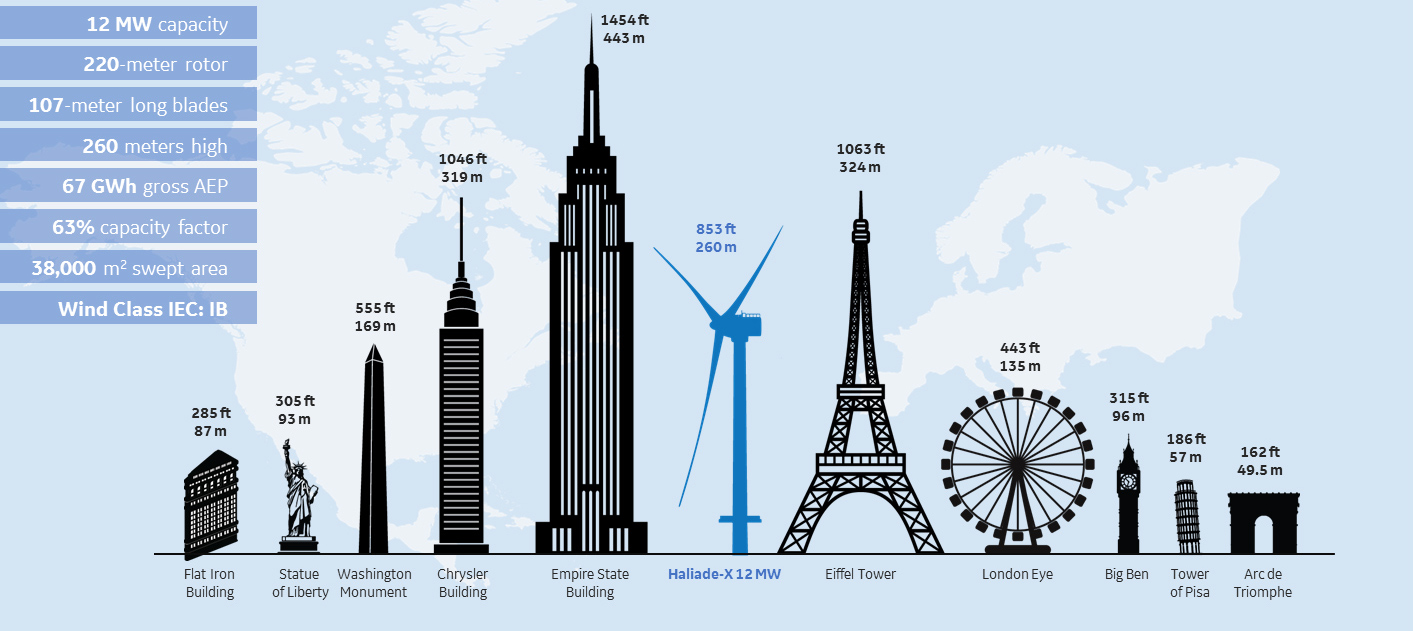World’s Largest Wind Turbine 12MW
Taking the turbine to its limits and beyond is a vital part of the development process. That’s why engineers at the ORE Catapult testing facility in the British seaside town of Blyth will spend the next five years pushing the various parts of the Haliade-X 12MW, including the generator, blades and rotor, to their limits and beyond to ensure that the new turbine not only meets but also exceeds industry standards. “We want to understand how the parts degrade over time,” says Sala, GE’s executive engineering leader for the Haliade X. “We want to see where and how components start to fail.”
The Haliade-X has the potential to make wind power much more efficient. The 12 MW design will allow operators to build wind farms with fewer turbines, lay fewer cables and reduce construction, maintenance and other capital costs. This should allow them to recoup their investments faster and help continue to push down the price of wind energy, which is already comparable to, or sometimes lower than, the cost of energy from fossil fuels.

Engineers at the ORE Catapult testing facility (top image) in the British seaside town of Blyth will spend the next five years pushing the various parts of the Haliade-X 12MW (above), including the generator, blades and rotor, to their limits and beyond to ensure that the new turbine not only meets but also exceeds industry standards. Top image credit: ORE Catapult. Above: GE Renewable Energy.
ORE has been testing wind turbine parts for the past five years, but the Haliade-X is its biggest subject yet. The nacelle — the metal box sitting on top of the tower that contains the motor and generator — is the heaviest ever built. The blades measure 107 meters long each, 18.6 meters more than the current longest blade.
Once installed at sea, the Haliade-X will face the same forces as previous generations of wind turbine but to a greater degree because of its huge size. For example, while the generator is turning within the nacelle, it will be subject to winds coming from many different directions — including updrafts that will add to the strain. The longer blades will be pushed and bent by the wind to a greater degree than any other blades currently on the market.
ORE Catapult engineers will start by testing the nacelle. They’ll attach the turbine’s drivetrain, which includes the direct drive generator, to a powerful test rig. The main element of the rig is a permanent magnet motor — which can generate 20,000 horsepower and was designed by GE Power Conversion. The motor can operate at 125 percent of the maximum power of the Haliade-X, which means it can run the drivetrain a quarter harder than its design specification.
Then there’s the force actuation system, which will mimic the pushing and pulling of the wind on the nacelle. “The motor provides the power of the wind, turning the shaft in either direction,” explains ORE Catapult project manager Mark Taylor. “The force application system replicates the other directions of force – providing ‘six degrees of freedom’ that accurately represent the extreme conditions that the turbine will be subjected to out at sea.”

With blades that are longer than a football field, the Haliade-X will have a generator capable of producing 12 megawatts — 2.5 MW more than current turbines and enough to supply the equivalent energy needed to supply 16,000 homes. It could be a game-changer for the power industry. Infographic credit: GE Renewable Energy.
Taylor and his team will simulate different wind conditions over different periods of time. They might run one load pattern 24 hours a day for 10 weeks, even though that would never be a real-life condition given that ocean wind patterns are not normally consistent for very long.
The point here is to find and eliminate any potential weak spots. During the testing, engineers will use data coming from sensors within and around the nacelle to build its digital twin. That virtual model of the machine will grow more sophisticated over the course of the testing and give engineers information they need to tweak and improve the final design.
After a year of machine torture at ORE, GE will install the first Haliade-X in the field to test in real-life conditions. “Our challenge is to get ahead of the nacelle in the field,” says Taylor. “If we can detect a weakness here, they can react before it becomes a problem in the field.”
The Haliade-X should be certified after the first year of testing. Engineers will dedicate the next four years of the contract to refining the model. The new turbine is expected to begin testing in the field in 2019 and start shipping in 2021.
Source : GE